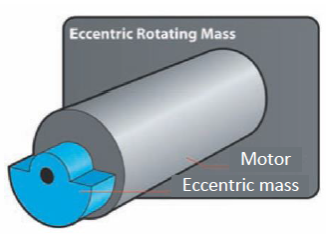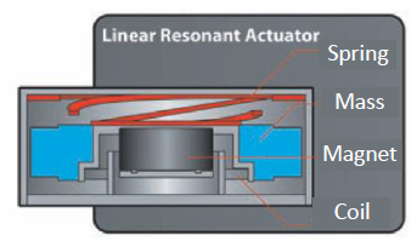When you hold a ball in your hand, you have the sense of its presence. You also have sensory information from your fingertips about the roughness or hardness on its surface, and even have the force feedback when you grip it tightly, all these cases are the tactile sensation. Technology advances rapidly, it is accelerating and changing our work and life dramatically, but what do you think we are missing? Date back to the days when people were using flip phones with alpha-numeric keys, where we pressed physical buttons to enter numbers and text messages, what we are missing is just the physical, tactile feeling that fingers around the keys. Despite smartphones are amazing and replacing buttons/keys with capacitive touch screens, but that merely make us stay in a 2D world on the reliance of audio and view cues, more and more developed devices are removing us further from the physical world.
As a result, haptic technology can be incorporated to provide us with tactile feedback and give us that sense of missing touch. Quadrant apply haptic technology to different industries, from virtual reality to surgical robots to touchscreens, haptics improves both realism and the precision of our interactions-imaging a surgeon is feeling what he or she is doing despite the separation from the patient, or a gamer receives powerful sensation of the slow grittiness of driving a car through mud, drawing a bow to shoot an arrow. Haptic technology has a vast field. Any technology that simulates the sensation of touch can be grouped under the umbrella of haptics. From simple button depression to force sensors and actuators that simulate resistance, texture, weight, shape, and tension, this category can get quite complicated.
Haptic motor converts the electrical energy into mechanical energy that gives us the sense of touch or tactile feedback. The haptic feedback has various forms of vibration, rotation, oscillation, resistance, motion, and force. With modern applications like touchscreens or gaming controllers, the standard method used to provide feedback is vibration. Like a flashing light or an audio cue, vibration is an effective indicator to register an action. That's why we say haptic motor as the vibration motor.
There are two main types of haptic motors: ERM (Eccentric RotationMass) motor and LRA (Linear Resonant Actuator) motor. The ERM motor can be further divided into two forms, which are composed of cylindrical ERM motor and coin shape ERM motor. Its common industry practice for the exposed cylindrical vibration motors to be called ERM vibration motors and the coin form factor to be called Coin, or Pancake, vibration motors.


Image I: ERM Motor Image II: LRA Motor
Our haptic motors are used across multiple applications, including Consumer Electronics, Automotive, Virtual Reality, Educational, Medical, and many others. Primary application areas of vibration motor may mainly penetrate the alerting to users, as the haptic technology develops day by day, enhancing the user experience and safety is becoming the mainstream strategy. Haptic motors involved in haptic technology bring humans back to the real world and diversify the interaction experiences. Generally, the integration of haptic vibration and touch screens makes the touch screen more intuitive and interactive, making the user feel immersive and more realistic. This intuitive and interactive experience can be easily found in games, smartphones, tablets, TVs, and digital signage turn up.
The integration of touch technology with consumer electronic devices has simplified the human beings' day-to-day activity. It has brought about a considerable amount of change in an individual's way of handling its professional, social, and personal life. The rising demand for mobility, wireless technology, cloud computing, and human-machine interface has laddered consumer electronics' transition to next-generation home automation devices. Gamers are attracted by challenging scenarios, amazing graphics, exciting online play, and useful game design, including haptic motor into the game controller, which significantly enhances the gaming experience and increases the player's entertainment level. Human beings' robots based on touch sense are well-performing robots and capable of interacting and identifying objects in their environments. These robots perceive properties like shape, size, texture, and hardness and distinguish between individual objects by the sense of touch. The perception strength of a mobile phone is affected by the weight of the device and the frequency of the driving vibration and feedback response time.
Haptic technology is widely used in the automotive field, including touchscreen of the automotive dashboard, steering wheel, gas pedal, and car seat, people can receive haptic feedback from them via motor vibration, which also gives warnings to the driver since these always are in contact with the driver. More haptic feedback has been introduced to the dashboard touchscreen to provide the operator with tactile information about button-presses. The steering wheel can make the most of its tactile feedback to remind the driver of the fuel level and other driving hazards. It vibrates to notify the driver when it detects a lane without indication. The gas pedal also provides haptic signals for the driver—these signals design to warn about the distance to the car ahead and the optimum time to change gears. Haptic gas pedals can also prevent the driver from speeding or slowing the car down due to the traffic. The car seat gives a haptic message to warn the driver of potential threats, and the seats vibrate to alert the driver if they change lanes too slowly, or to any other signs of driver fatigue. Vibrations can also be used in car seats to vibrate massage and relax passengers. Haptic devices conveniently deliver the information and exhibit multi-touch functionality, high performance, and faster response, thus making the driving easier, safer, and comfortable.
Virtual reality consists of head-tracked and stereoscopic virtual worlds with spatialize sound, and haptic feedback, virtual reality systems equipped with haptic devices in the field of education help enhance the learning process. It benefits the user by providing realism of simulations by force or tactile feedback.
Similarly, the haptic motor is more and more adopted in haptic tools that exceedingly diverse and assists the educational industry. The traditional learning process focuses on visual (reading) and auditory (hearing) learning, but haptic based virtual education is an entirely different learning method and style. Haptics tools with a variety of educational settings are used to teach and train students in specific techniques. Such devices permit the students to interact with experiments and experience the demonstration of gravity, friction, momentum, and other forces.
Our vibration motors are used in a variety of medical devices, including handheld health and beauty products, which both have becoming the trendy applications of haptic motors. Women are keen to maintain their beauty through various skin care products, skin massage, and even cosmetic surgery. Nowadays, different skincare products are getting more popular and more strongly sought after by people. The new generation of skincare products, such as cleansers, facial devices, anti-wrinkle, and make-up devices, are all driven by tactile technology with tactile motors. Medical applications using vibration motors have a wide range of practical uses, from taking patient's temperature to diabetes screening. Also, vibrations are absolutely a way to alert the user surrounded by potentially noisy environments, or the situation where other patients may be asleep. Let's see some specific medical applications. For example, in neuropathy, it is possible to use vibrations to test a patient's response to varying touch levels. Similar to the vibration massager applications, the facilitates pain relief also uses the vibration motors. Applying vibrations to areas of pain or muscle tension can alleviate stress and discomfort for long-term chronic pain sufferers. Athletics or patients undergoing physiotherapy may also benefit from vibration massagers, and physiotherapists can work longer with less fatigue.
Without a doubt, haptic technology will rapidly adopt and innovate in the next few years. At Quadrant, we transform haptic motors into custom products. Contact us to find out more information.
